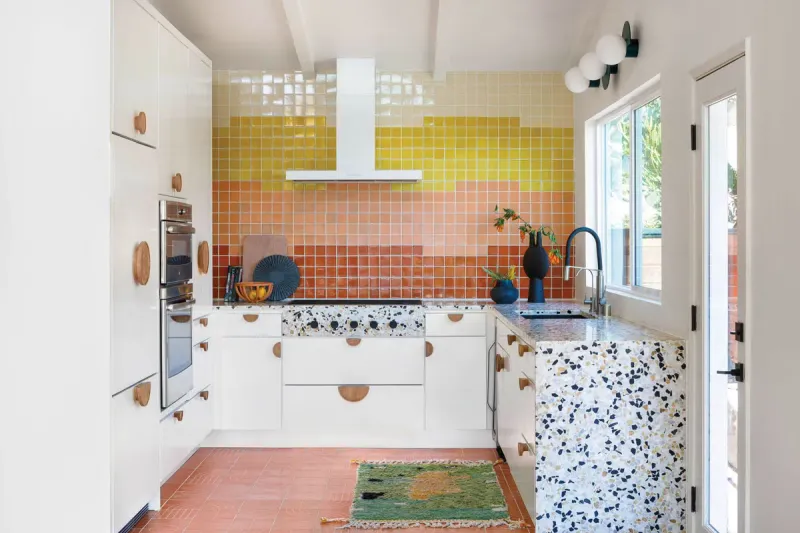In the world of interior design, trends come and go, and what’s stylish today might be passé tomorrow.
Countertops are no exception, playing a pivotal role in defining the aesthetic of a kitchen or bathroom. While some materials exude timeless appeal, others quickly reveal their age.
In this article, we’ll explore 7 countertop materials that can make your home look outdated.
From the once-trendy to the now-tired, discover which surfaces to avoid if you’re aiming for a modern look.
1. Tile Countertops

Tile countertops were once a staple in kitchens, particularly during the 1980s. Their modular nature allowed homeowners to mix and match colors, creating custom patterns and designs.
However, as trends shifted towards seamless, grout-free surfaces, tile countertops began to look dated. The grout lines, often difficult to clean, add to the appearance of age.
The tactile texture, while initially appealing, now seems out of place in modern kitchens. For those craving nostalgia, it might remind them of a childhood home.
Nonetheless, it’s time to move beyond this relic of past decades.
2. Laminate Surfaces

Laminate surfaces gained popularity in the mid-20th century, celebrated for their affordability and variety of patterns.
During the 1970s, woodgrain laminates were particularly popular, offering a cheaper alternative to real wood. Despite their initial charm, these surfaces wear quickly, showing scratches and burns.
The glossy finish that was once a sign of modernity now feels out of place in contemporary kitchens. As materials like granite and quartz gained traction, laminate countertops began to reveal their age.
For a touch of vintage flair, laminate might work, but it’s not for the modern minimalist.
3. Butcher Block

Butcher block countertops exude a warm, rustic charm that was particularly favored in country-style kitchens.
Made from strips of wood glued together, they offered a natural, inviting surface. However, their need for constant maintenance—like oiling to prevent drying and warping—makes them less practical today.
The visible knife marks and stains tell tales of countless meals prepared, but they also highlight wear. While some appreciate the character, others see it as a sign of age.
In a world gravitating towards sleek, low-maintenance options, butcher block seems like a memory of the past.
4. Granite Overload

Granite burst onto the scene in the 1990s, quickly becoming the hallmark of a luxurious kitchen. Its durability and natural stone appeal made it a favorite.
Yet, the dark, busy patterns that were once all the rage can now feel overwhelming and dated.
The stark contrast with light wood cabinetry was a popular design choice, but today’s trends favor lighter, more uniform surfaces.
Granite’s undeniable strength remains its asset, yet its aesthetic has transitioned from cutting-edge to classic—sometimes too classic for those chasing contemporary vibes.
5. Concrete Countertops

Concrete countertops emerged as a trendy choice for industrial-style kitchens, offering a unique, raw aesthetic.
Their rough texture and natural patina add character and individuality. Unfortunately, they also crack easily, and the maintenance required to seal and protect them deters many.
While some cherish the industrial look, others find it cold and uninviting. The charm of the unfinished appearance may appeal to a niche audience, but for those seeking a sleek, polished space, concrete feels out of place.
In an ever-evolving design landscape, it’s more niche than neutral.
6. Terrazzo

Terrazzo, with its colorful chips set in a cement or resin matrix, recalls retro charm. Popular in the mid-20th century, it offered a playful, artistic touch to kitchens.
Its durability and ability to hide stains were initially appealing, but its bold patterns can feel overwhelming today.
The speckled appearance, though distinctive, can clash with modern minimalist aesthetics. While some see terrazzo as a vintage delight, others view it as a visual distraction.
As design preferences shift towards simplicity, terrazzo’s once vibrant allure now reads as relic from another era.
7. Corian

Corian, an engineered solid surface, was introduced as a cutting-edge material in the late 1960s. Its seamless appearance and versatility made it a popular choice through the 1980s.
Integrated sinks and rounded edges were hallmarks of this material’s design.
However, as natural stone gained popularity, Corian began to show its age. While it offers a smooth, sleek look, it lacks the depth and variation of more contemporary materials.
For those who value homogeneity, it may still appeal, but for others, it feels like a relic of its time. As design evolves, Corian’s star has dimmed.

